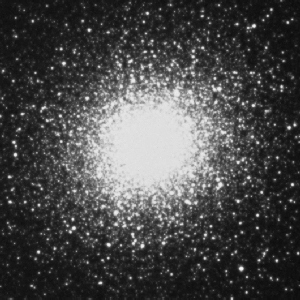The globular cluster M13 in the constellation Hercules
Click on image for full size
the Space Telescope Science Institute and NASA
Globular Clusters
If you think that this globular cluster looks like a very round
elliptical galaxy, you would
be right! Elliptical galaxies and globular clusters have a lot in
common. There is no gas or dust in a globular cluster, and the stars
are old. In fact, globular clusters may be the some of the oldest
objects in the universe.
The big difference is size! Globular clusters contain hundreds of
thousands or millions of stars. Elliptical galaxies can contain
hundreds of billions of stars! And while elliptical galaxies are
sometimes round, globular clusters are never elliptical.
Globular clusters are found both in spiral galaxies and elliptical
galaxies. The Milky Way,
for example, has over one hundred globular clusters throughout it's
halo.
You might also be interested in:

Spiral galaxies may remind you of a pinwheel. They are rotating disks of mostly hydrogen gas, dust and stars. Through a telescope or binoculars, the bright nucleus of the galaxy may be visible but the
...more
Astronomers have used the Hubble Space Telescope (HST) to learn more about a unique type of star called a blue straggler. Blue stragglers are stars located in densely packed globular clusters. They are
...more
In the 1960's, the United States launched some satellites to look for very high energy light, called Gamma Rays. Gamma Rays are produced whenever a nuclear bomb explodes. The satellites found many bursts
...more
During the early 1900's, which is not very long ago, astronomers were unaware that there were other galaxies outside our own Milky Way Galaxy. When they saw a small fuzzy patch in the sky through their
...more
Neutron Stars are the end point of a massive star's life. When a really massive star runs out of nuclear fuel in its core the core begins to collapse under gravity. When the core collapses the entire star
...more
When stars like our own sun die they will become white dwarfs. As a star like our sun is running out of fuel in its core it begins to bloat into a red giant. This will happen to our sun in 5 Billion years.
...more
What's in a Name: Arabic for "head of the demon" Claim to Fame: Represents Medusa's eye in Perseus. A special variable star that "winks" every 3 days. Type of Star: Blue-white Main Sequence Star, and
...more















